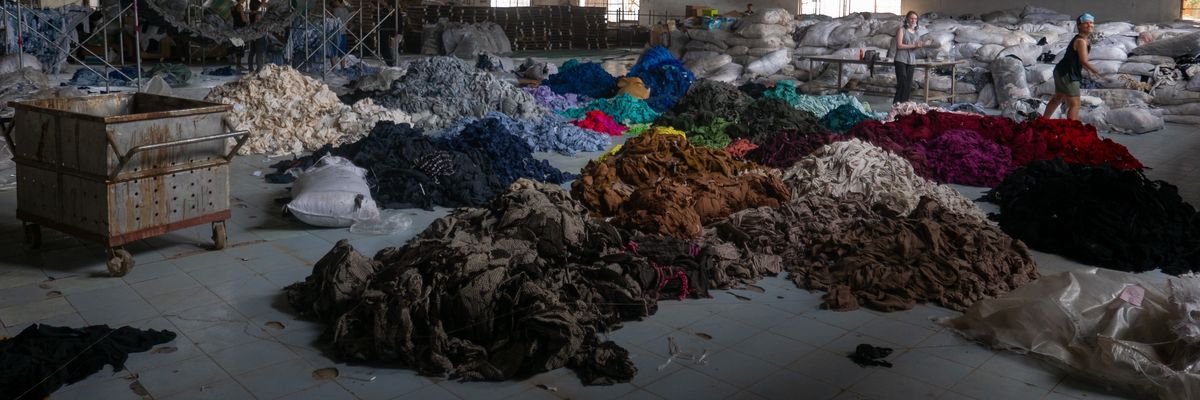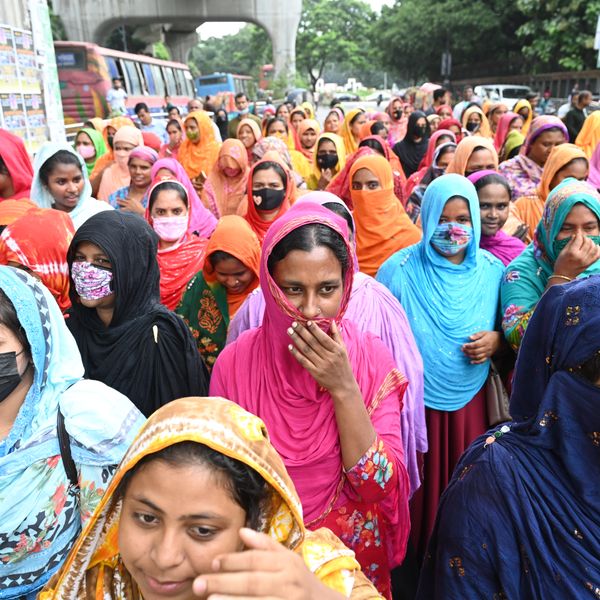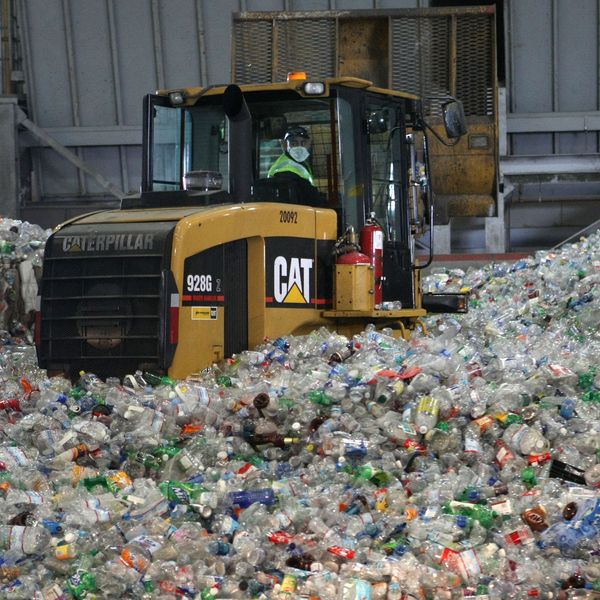
Piles of sorted clothes at an abandoned factory.
Fast Fashion Harms Workers and the Planet
To cheaply and quickly reproduce the latest styles, manufacturers contract to companies in some of the poorest countries in the world where wages are low and standards of protection for the workers and the environment are ignored.
We all like to get something new, be it clothes, a house, a car, or something for the home. It gives us a feeling of a new start. And with the many forms of shopping through commercial centers, stores, catalogs, and the internet, we have an enormous selection from which to choose. To make buying even easier, there are numerous ways to pay. We have credit cards, debit cards, and digital and telephone transfers so that we don’t have to worry about not having money. Our happiness is guaranteed.
The most common purchases are clothes, and now we have Fast Fashion, a system where we can be up to date on all the latest styles. What does this mean and how does it impact us and the rest of the world?
It’s natural for us, at any age, to want the “latest” model, a sign to others that we are modern, in-the-know, and prepared for the world of work, recreation, the beach, or the city. To that end textile manufacturers can rush into production the same styles worn by influencers and people of fashion in the most rapid way and keep the prices low so that you will be tempted to buy. Also supporting the Fast Fashion trend are the free trade treaties that reduce or eliminate tariffs, which also keep down prices. But in reality is Fast Fashion a benefit?
Fast Fashion may seem like a good thing in providing a constant supply of the newest designs, but it takes its toll on the environment, labor practices, and our own comfort.
A report in Treehugger, an environmental magazine, says that Americans buy an average of 70 items of clothing a year, and later much of it remains forgotten in the closet. A similar study by a German university estimated that 60% of clothing purchases are not necessary and are seldom worn. In rapid time the style passes and the garment loses it’s charm.
Fast Fashion may seem like a good thing in providing a constant supply of the newest designs, but it takes its toll on the environment, labor practices, and our own comfort. Fast Fashion means that manufacturers contract to companies in some of the poorest countries in the world—Bangladesh, Vietnam, Cambodia, and others where wages are low and standards of protection for the workers and the environment are ignored—and they use the cheapest of synthetic materials. The waste products—the dyes and chemicals and byproducts—are often pitched into the environment, the waterways, and the air, causing health problems for the people and the environment of the area. Workers, mostly women, work long hours without benefits or safety measures.
Because the fabrics and the process of producing all these new clothes are of poor quality, they soon lose their “fresh look.” They stretch out of shape, and the colors deteriorate. Synthetic fabrics cause skin allergies for many wearers. The cloth traps heat inside, making the garments uncomfortable. Styles pass, the items are no longer worn. Low prices are offset by the product’s short life span.
Fast Fashion has also created an environmental hazzard. Tons of discarded, unwanted clothes have become a serious problem as the synthetic materials do not break down. Tons of used, unwanted apparel are shipped to poor countries to be distributed, but much is waste because of its poor condition. Areas in Kenya and Chile and other poor countries have become dumping grounds for those formerly high-fashion products.
How can we help create a more postive environment and still be “well dressed?” By being prudent when shopping, whether it’s for clothes or household products such as curtains or bedsheets. Ask yourself if the purchase is really necessary, or do you buy on impulse? Look for quality. Check labels for fabric content and where the garment was made. Is it an item that will last?
Buying in “used shops” can yield quality items at comfortable prices. It’s a form of recylcing. Buy clothing made of natural fibers, although cotton and denim also contaminate from their use of fertilizers and water in production. Parents can teach their children that they do not need to have the latest style all the time.
A good sign is that there is a growing consciousness among major stores and brands to check the abuses caused by Fast Fashion by carrying only products made under just and safe conditions for workers and the environment. Through the use of careful buying habits we can help improve conditions for workers and the environment.
An Urgent Message From Our Co-Founder
Dear Common Dreams reader, The U.S. is on a fast track to authoritarianism like nothing I've ever seen. Meanwhile, corporate news outlets are utterly capitulating to Trump, twisting their coverage to avoid drawing his ire while lining up to stuff cash in his pockets. That's why I believe that Common Dreams is doing the best and most consequential reporting that we've ever done. Our small but mighty team is a progressive reporting powerhouse, covering the news every day that the corporate media never will. Our mission has always been simple: To inform. To inspire. And to ignite change for the common good. Now here's the key piece that I want all our readers to understand: None of this would be possible without your financial support. That's not just some fundraising cliche. It's the absolute and literal truth. We don't accept corporate advertising and never will. We don't have a paywall because we don't think people should be blocked from critical news based on their ability to pay. Everything we do is funded by the donations of readers like you. Will you donate now to help power the nonprofit, independent reporting of Common Dreams? Thank you for being a vital member of our community. Together, we can keep independent journalism alive when it’s needed most. - Craig Brown, Co-founder |
We all like to get something new, be it clothes, a house, a car, or something for the home. It gives us a feeling of a new start. And with the many forms of shopping through commercial centers, stores, catalogs, and the internet, we have an enormous selection from which to choose. To make buying even easier, there are numerous ways to pay. We have credit cards, debit cards, and digital and telephone transfers so that we don’t have to worry about not having money. Our happiness is guaranteed.
The most common purchases are clothes, and now we have Fast Fashion, a system where we can be up to date on all the latest styles. What does this mean and how does it impact us and the rest of the world?
It’s natural for us, at any age, to want the “latest” model, a sign to others that we are modern, in-the-know, and prepared for the world of work, recreation, the beach, or the city. To that end textile manufacturers can rush into production the same styles worn by influencers and people of fashion in the most rapid way and keep the prices low so that you will be tempted to buy. Also supporting the Fast Fashion trend are the free trade treaties that reduce or eliminate tariffs, which also keep down prices. But in reality is Fast Fashion a benefit?
Fast Fashion may seem like a good thing in providing a constant supply of the newest designs, but it takes its toll on the environment, labor practices, and our own comfort.
A report in Treehugger, an environmental magazine, says that Americans buy an average of 70 items of clothing a year, and later much of it remains forgotten in the closet. A similar study by a German university estimated that 60% of clothing purchases are not necessary and are seldom worn. In rapid time the style passes and the garment loses it’s charm.
Fast Fashion may seem like a good thing in providing a constant supply of the newest designs, but it takes its toll on the environment, labor practices, and our own comfort. Fast Fashion means that manufacturers contract to companies in some of the poorest countries in the world—Bangladesh, Vietnam, Cambodia, and others where wages are low and standards of protection for the workers and the environment are ignored—and they use the cheapest of synthetic materials. The waste products—the dyes and chemicals and byproducts—are often pitched into the environment, the waterways, and the air, causing health problems for the people and the environment of the area. Workers, mostly women, work long hours without benefits or safety measures.
Because the fabrics and the process of producing all these new clothes are of poor quality, they soon lose their “fresh look.” They stretch out of shape, and the colors deteriorate. Synthetic fabrics cause skin allergies for many wearers. The cloth traps heat inside, making the garments uncomfortable. Styles pass, the items are no longer worn. Low prices are offset by the product’s short life span.
Fast Fashion has also created an environmental hazzard. Tons of discarded, unwanted clothes have become a serious problem as the synthetic materials do not break down. Tons of used, unwanted apparel are shipped to poor countries to be distributed, but much is waste because of its poor condition. Areas in Kenya and Chile and other poor countries have become dumping grounds for those formerly high-fashion products.
How can we help create a more postive environment and still be “well dressed?” By being prudent when shopping, whether it’s for clothes or household products such as curtains or bedsheets. Ask yourself if the purchase is really necessary, or do you buy on impulse? Look for quality. Check labels for fabric content and where the garment was made. Is it an item that will last?
Buying in “used shops” can yield quality items at comfortable prices. It’s a form of recylcing. Buy clothing made of natural fibers, although cotton and denim also contaminate from their use of fertilizers and water in production. Parents can teach their children that they do not need to have the latest style all the time.
A good sign is that there is a growing consciousness among major stores and brands to check the abuses caused by Fast Fashion by carrying only products made under just and safe conditions for workers and the environment. Through the use of careful buying habits we can help improve conditions for workers and the environment.
- Opinion | This Peak Buying Season, It's Time to Rethink Fashion's Growth Obsession | Common Dreams ›
We all like to get something new, be it clothes, a house, a car, or something for the home. It gives us a feeling of a new start. And with the many forms of shopping through commercial centers, stores, catalogs, and the internet, we have an enormous selection from which to choose. To make buying even easier, there are numerous ways to pay. We have credit cards, debit cards, and digital and telephone transfers so that we don’t have to worry about not having money. Our happiness is guaranteed.
The most common purchases are clothes, and now we have Fast Fashion, a system where we can be up to date on all the latest styles. What does this mean and how does it impact us and the rest of the world?
It’s natural for us, at any age, to want the “latest” model, a sign to others that we are modern, in-the-know, and prepared for the world of work, recreation, the beach, or the city. To that end textile manufacturers can rush into production the same styles worn by influencers and people of fashion in the most rapid way and keep the prices low so that you will be tempted to buy. Also supporting the Fast Fashion trend are the free trade treaties that reduce or eliminate tariffs, which also keep down prices. But in reality is Fast Fashion a benefit?
Fast Fashion may seem like a good thing in providing a constant supply of the newest designs, but it takes its toll on the environment, labor practices, and our own comfort.
A report in Treehugger, an environmental magazine, says that Americans buy an average of 70 items of clothing a year, and later much of it remains forgotten in the closet. A similar study by a German university estimated that 60% of clothing purchases are not necessary and are seldom worn. In rapid time the style passes and the garment loses it’s charm.
Fast Fashion may seem like a good thing in providing a constant supply of the newest designs, but it takes its toll on the environment, labor practices, and our own comfort. Fast Fashion means that manufacturers contract to companies in some of the poorest countries in the world—Bangladesh, Vietnam, Cambodia, and others where wages are low and standards of protection for the workers and the environment are ignored—and they use the cheapest of synthetic materials. The waste products—the dyes and chemicals and byproducts—are often pitched into the environment, the waterways, and the air, causing health problems for the people and the environment of the area. Workers, mostly women, work long hours without benefits or safety measures.
Because the fabrics and the process of producing all these new clothes are of poor quality, they soon lose their “fresh look.” They stretch out of shape, and the colors deteriorate. Synthetic fabrics cause skin allergies for many wearers. The cloth traps heat inside, making the garments uncomfortable. Styles pass, the items are no longer worn. Low prices are offset by the product’s short life span.
Fast Fashion has also created an environmental hazzard. Tons of discarded, unwanted clothes have become a serious problem as the synthetic materials do not break down. Tons of used, unwanted apparel are shipped to poor countries to be distributed, but much is waste because of its poor condition. Areas in Kenya and Chile and other poor countries have become dumping grounds for those formerly high-fashion products.
How can we help create a more postive environment and still be “well dressed?” By being prudent when shopping, whether it’s for clothes or household products such as curtains or bedsheets. Ask yourself if the purchase is really necessary, or do you buy on impulse? Look for quality. Check labels for fabric content and where the garment was made. Is it an item that will last?
Buying in “used shops” can yield quality items at comfortable prices. It’s a form of recylcing. Buy clothing made of natural fibers, although cotton and denim also contaminate from their use of fertilizers and water in production. Parents can teach their children that they do not need to have the latest style all the time.
A good sign is that there is a growing consciousness among major stores and brands to check the abuses caused by Fast Fashion by carrying only products made under just and safe conditions for workers and the environment. Through the use of careful buying habits we can help improve conditions for workers and the environment.
- Opinion | This Peak Buying Season, It's Time to Rethink Fashion's Growth Obsession | Common Dreams ›

